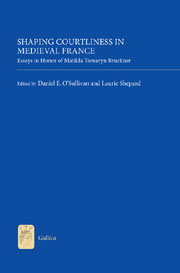Book contents
- Frontmatter
- Contents
- List of Illustrations
- Acknowledgements
- Introduction
- Matilda Tomaryn Bruckner: A Bibliography
- Part I Shaping Real and Fictive Courts
- Part II Shaping Courtly Narrative
- Meraugis de Portlesguez and the Limits of Courtliness
- The Art of “Transmutation” in the Burgundian Prose Cligés (1454): Bringing the Siege of Windsor Castle to Life for the Court of Philip the Good
- Thomas's Raisun: Désir, Vouloir, Pouvoir
- Humanimals: The Future of Courtliness in the Conte du Papegau
- A Matter of Life or Death: Fecundity and Sterility in Marie de 139 France's Guigemar
- Le Roman de la Rose, Performed in Court
- Part III Shaping Women's Voices in Medieval France
- Part IV Shaping the Courtly Other
- Envoi
- List of Contributors
- Index
- Tabula Gratulatoria
- Already Published
Meraugis de Portlesguez and the Limits of Courtliness
from Part II - Shaping Courtly Narrative
Published online by Cambridge University Press: 05 May 2013
- Frontmatter
- Contents
- List of Illustrations
- Acknowledgements
- Introduction
- Matilda Tomaryn Bruckner: A Bibliography
- Part I Shaping Real and Fictive Courts
- Part II Shaping Courtly Narrative
- Meraugis de Portlesguez and the Limits of Courtliness
- The Art of “Transmutation” in the Burgundian Prose Cligés (1454): Bringing the Siege of Windsor Castle to Life for the Court of Philip the Good
- Thomas's Raisun: Désir, Vouloir, Pouvoir
- Humanimals: The Future of Courtliness in the Conte du Papegau
- A Matter of Life or Death: Fecundity and Sterility in Marie de 139 France's Guigemar
- Le Roman de la Rose, Performed in Court
- Part III Shaping Women's Voices in Medieval France
- Part IV Shaping the Courtly Other
- Envoi
- List of Contributors
- Index
- Tabula Gratulatoria
- Already Published
Summary
Identifying the courtly heroine in an Old French romance often requires only a glance: her remarkable beauty makes her easy to recognize. Lengthy enumerations of a lady's perfect physical traits – from her long blond hair to her slim hips – further underscore the importance of her visible attractiveness. While intangible traits are essential, too, composers typically pay them less heed. Such is not the case, however, in Raoul de Houdenc's thirteenth- century Meraugis de Portlesguez. From the opening episode, the tale's heroine, Lidoine, stands out from her peers not only for her extraordinary loveliness, but also for her exceptional courtliness. The attention to her inner qualities as well as on her looks allows Raoul to examine the importance of each in a courtly lady and suggests that the former plays a key role in determining worth. The romance's eponymous hero also holds courtliness in particularly high regard, both in matters of love and in his own behavior. Yet Raoul's depiction of courtliness proves to be more complex than it originally seems. Even as he insists upon the privileged place of inner nobility, Raoul invites the audience to consider carefully the relationship between courtliness and success, revealing that courtly behavior is no guarantee of victory.
- Type
- Chapter
- Information
- Shaping Courtliness in Medieval FranceEssays in Honor of Matilda Tomaryn Bruckner, pp. 83 - 94Publisher: Boydell & BrewerPrint publication year: 2013



